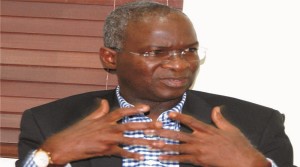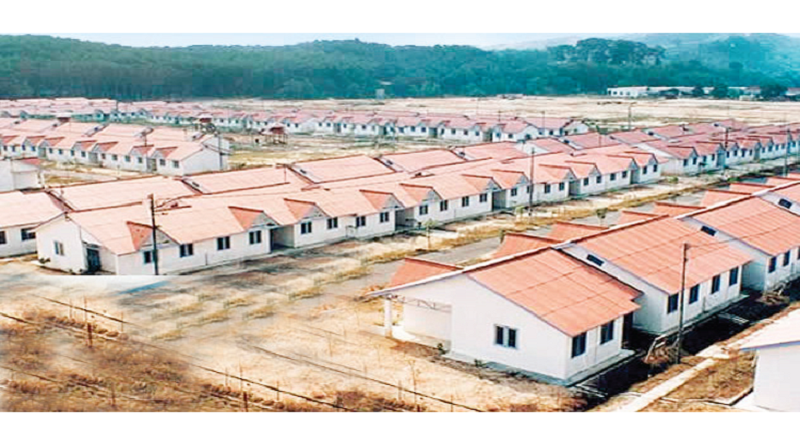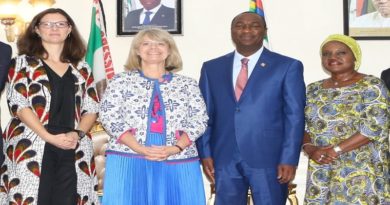Fashola unveils housing delivery plans
Ahead of the Affordable Housing Summit which opens Monday in Abuja, the Minister of Power, Works and Housing, Mr. Babatunde Fashola , has given an insight into how the Federal Government plans to achieve a sustainable housing programme for the country saying it is only through standardization of designs, even while taking into cognizance the cultural preferences of the nation’s geopolitical zones, that industrialization and mass housing can be possible.
Fashola, who met with National Assembly Committees on Housing to present the Implementation Plan of the 2016 Budget as it concerns the National Housing Programme during the week, said although there could be the desire out there that government should rush out and do what everybody has done in the past, and probably end up with the same old results, the focus of the present administration was more on a sustainable housing plan.
Fielding questions from Members of the House of Representatives Committee on Housing, Fashola, who said the little over N30 billion allocated to Housing in the 2016 Budget would not solve the nation’s housing problem, added that Government was desirous of delivering a plan that would work beyond its tenure.
The Minister, who cited two housing models – Singapore Housing Development Programme and the United Kingdom Housing Scheme – to explain the need for sustainability, said while the UK model started in 1918 and the Singaporean model in 1960, one common factor in those countries was “a near uniformity of design†when one looked outside, adding, “In whatever community that they build, as designs vary, they remain the same within one communityâ€.
According to the Minister, Singapore, a country of about three million people, though they have implemented their housing design, an almost uniform design, successfully since 1960 till now, as at 2013 and 2014, over 80 per cent of the people had become home owners with the rest still accommodated under the rental scheme. “So they don’t even have a 100 percent house ownershipâ€, he noted.
For the United Kingdom, whose Housing programme, he said, started almost 100 years ago, only about 64 per cent of about 56 million people in the United Kingdom, England and Wales, have been accommodated as home owners under the housing programme while others were still accommodated under the rental schemes.
Citing Lagos State as an example of where Housing was given higher allocation, the Minister said, “Yes there is a temptation to implement a 2016 Budget but, truth be told, how much is the 2016 Budget? A little over N30 billion; it is not going to solve our housing problem. The Budget for Housing for my state in 2015 was in excess of N40 billion and it hasn’t solved all the problems in housing in that stateâ€.
“So, it is not just about implementing a budget; when we get to full scale clearly we will not be talking of N35 billion; we will be talking of hundreds of billions and trillions to keep the value chain going because it is an extensive value chainâ€, the Minister said.
In terms of design, Fashola explained that the potential that government started with was possible 480 designs, “different designs, with different sizes of windows, different sizes of doors, different sizes of tilesâ€, pointing out that they were not the basis to achieve what the administration wanted to achieve, which, according to him, are “employment sustainability and driving industrializationâ€.
Commending the Technical Department of the Ministry which articulated the designs and reduced them to manageable numbers, Fashola explained that the way to drive industrialization was standardization and mass production adding that where the windows, tiles and other housing accessories were different, standardization would be impossible.
“So this department, in my view, deserves commendation for reducing a potential 480 designs a year, which can be over 1,000 over four years, to 12 designs which we now have and which we want to reduce further to about six in a way that it responds to the broad cultural challenges of our countryâ€, he said.
Explaining further the importance of the cultural basis for the National Housing programme, the Minister told the Committee, “Some of the feedbacks that we found, because the basis for cultural design first is consultation; you don’t just sit down and design and say go and give them, is that some of the buildings built for the IDPs, they refused to live there. It was a cultural shock for them. They were transiting from what they were used to into what they were not used to, so they stayed outsideâ€.
“It happened in Rwanda too immediately after the genocide. This is the extent of research that we have done before we begin to build. We have consulted not only within ourselves, but with architects from outside, from the six geopolitical zones. What do your people want, what are they likely to accept?â€, he said pointing out that feedbacks had revealed that in some cultures some people do not accept toilets inside the house while in others in-laws are not allowed to use toilets in the same house.
Responding to a question as to whether to build one bedrooms for the low income group who are likely to have more children than the elite group, Fashola explained, “The one bedrooms we are building are not the standard one-bedrooms, they are a minimum of 60 square metres which leaves room for small earning families, low income people, hoping that we can fit the design to their budget to be able to possibly partition within and live their livesâ€, adding that the rooms would be bigger.

According to the Minister, “They are very big one bedrooms, because affordability lies at the heart of what we are doing. Are we building houses that people will look at or are we building a house people can afford to say okay let me try? The issue of affordability is being given every due considerationâ€.
Such consideration, the Minister recalled, was demonstrated at a recent symposium by Shelter Afrique hosted in Abuja by the Ministry where one of the decisions taken was to launch a design competition titled, “Five Thousand for Five Thousand Initiativeâ€, “to see if anybody could design a house for $5,000, which is about N1 million, and then provide a mortgage for people to pay over a periodâ€.
“That programme is starting and if it is successful, Shelter Afrique is ready to fund 5,000 of that. That is why it is called 5,000 for 5,000 Initiativeâ€, he said adding that some of the designs that were presented to the Ministry as “Affordableâ€, were houses built in Haiti where the bathrooms were outside. “Do we want to build such houses for our people?†Fashola asked adding that consultations were also extended to people from Malawi, Kenya, the United States and the United Kingdom at that symposium.
On the inability of some states to provide land yet for the programme, Fashola recalled the insistence of the House that every state must benefit instead of the proposal of the Ministry during its Budget defence that states should access the programme on the basis of willingness adding that it was on that basis the bulk sum presented in the Budget proposal by the Ministry “was divided to go roundâ€.
Earlier in his opening remarks, Fashola, who said designs being presented to the House came from consultations with people of diverse background who constitute the membership of the Ministry, explained that what the Ministry inherited when he assumed office was a Housing Plan of 2012 adding that the important part of that plan was a Statement of Intent to provide affordable housing for Nigerians.
According to the Minister, “It did not state how that housing would be provided, what design, what cost and so on and so forth. And that is where we have taken off trying to develop what we call a Housing Programmeâ€. He added that there has been a few interventions again that the Ministry inherited, “direct constructions by the Ministry, housing interventions that will deliver about 360 units of houses in four states or thereaboutsâ€.
He said apart from those interventions, housing developments had taken place before now through PPPs adding, “The PPP department of the Ministry was created, I think, in 2004, so they inherited some of the programmes that had started before their advent and they continued. They have operated largely with Memoranda of Understanding (MoUs) and Development Lease Agreementsâ€.
Fashola said the last review of the National Housing Programme, which according to him, was done in-house, showed that the PPP initiatives were expected to deliver about 21,008 housing units adding, however, that to date those signed on had delivered about 2,750 housing units “over a substantial period of years with a return rate of just about 13 per centâ€.
Highlighting some of the problems of the PPPs to include inability to raise funds and building away from the market “so the people that are the target really of the housing units cannot afford themâ€, the Minister declared.
“That review has necessitated the presentation that you will receive todayâ€, he told the Committee adding that although some of the PPPs always professed that they would deliver 10,000 units, when scrutinized it was discovered that those who promised that they would give us 10,000 units could not show where they built I,000 units of houses.
He noted that if the Ministry should work with the multiple designs being sent by the PPPs, the production of all the materials in a harmonious form to build an ecosystem that would employ the local capacity that would engender diversification and strengthen the SMEs and cottage industries to be the supply chain for the housing objectives would be impossible.
“Our objective is what we have tried to do in the document that will be presented to youâ€, he told the Committee, adding that the Ministry had also taken some of the first steps by presenting to the public recently its Energy Efficient building model in collaboration with its partners – GRZ Institute for Development – which, according to him, the Ministry intends to incorporate into the National Building Code.
Presenting details of the Programme, Architect Sani Gidado, who was Chairman of the Technical Committee responsible for the designs, recalled that under the 2016 appropriation, the Ministry allocated N35.6 billion for National Housing Programme adding that Extensive planning and widespread consultations have been carried out and now the Ministry was “technically ready for the implementation of the programme in the 36 states of the Federation and the FTC in line with the Appropriation Actâ€.
Gidado, who said the programme was set for implementation “under the short term strategiesâ€, informed the Committee that so far out of the 36 states written for land, only 19 states, consisting Ogun, Jigawa, Kwara, Kogi, Sokoto, Zamfara, Ekiti, Kebbi, Adamawa, Abia, Ondo, Yobe, Akwa Ibom, Benue, Bauchi, Osun, Anambra, Oyo and Plateau, had responded adding that out of that number, two states, Akwa Ibom and Benue, just made an offer without a specific allocation.
On the types of houses to be built, Gidado who said they had been designed to suit the geopolitical zones of the country, listed them to include 1,2 and 3 bedroom block of flats, blocks of 1,2 and 3 bedrooms, 1,2 and 3 bedroom semi-detached bungalows and 1 and 3 bedroom terrace bungalows.
The designs, according to him, were done by the technical committee set up in the Ministry and composed of people from different parts of the country adding that even during the planning process the Committee had to make a lot of research before the designs were done.
“We had to know what we need for what locationâ€, he said adding that, unlike the Shagari Housing Programme where there was only one standard design all over the country, the Ministry has come out with designs “specifically for the Southern states because of their climate, their ways of life and for the North, especially the far North where we have temperature difficultiesâ€.
“We have very excessive hot and dry weather, like in my own home state, we know their ways of life, they need courtyards to stay outside during hot seasons like now and so on and so forth. We have taken all these into consideration. When you look at the bungalows for example, they are targeting the far North, they are really in such a way that the living standards and way of life of the people in those areas have been taken into consideration in the design.
“We know some people will like to stay in the courtyard possibly in addition to the kitchen and possibly cook outside and even sleep in the courtyard when there is no light, we have made provision for those. So the designs are all thereâ€, he said.
He said in the course of planning and widespread consultations, the Ministry noted that industrialized building was the way to go “if the huge housing deficit facing the country is to be addressed.â€
At the Senate, Fashola told the Committee that what the government was trying to do was to move away from the models of the past to the extent that those models had not provided the speed and scale of response that government seeks to achieve adding that the Ministry had relied largely on its in-house capacity to produce the framework of the nature the housing programme would assume as most private sector proposals were not put forward by professional building construction engineers.
Fashola, who said there were already 12 models of houses that would fit different geopolitical zones of the country, added that in coming out with the designs, the Ministry took cognizance of the cultural affinities and behavioural patterns as well as the climatic conditions of the zones.
He added that the Ministry was looking beyond implementing this year’s N35 billion budget for housing to a sustainable housing programme that would be nationally accepted and develop on its own and adding that although N35 billion was only a drop in the pool for the national housing programme, the Ministry wished to use it to prove that its concept would work.
While also presenting the script on plans and modalities for the implementation of the National Housing Programme, Chairman of the Ministry’s Technical Committee responsible for the designs, Architect Sani Gidado, told the Senate Committee that although the technology and human capacities required to embark on the industrialized housing system was not yet available, such technological materials had been identified and would be achieved in due course adding that implementation would start meanwhile by the conventional building method.




